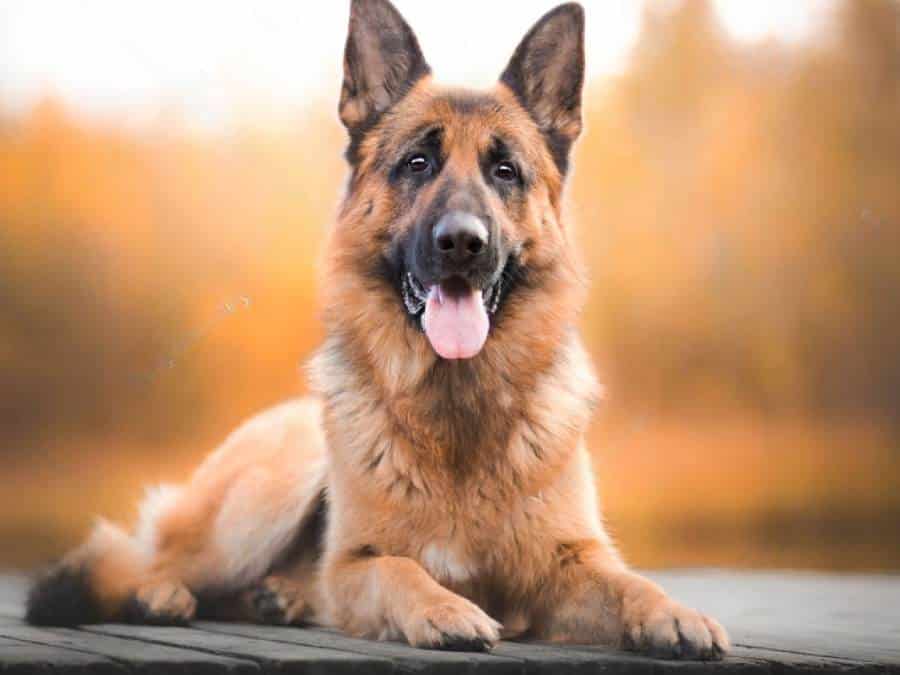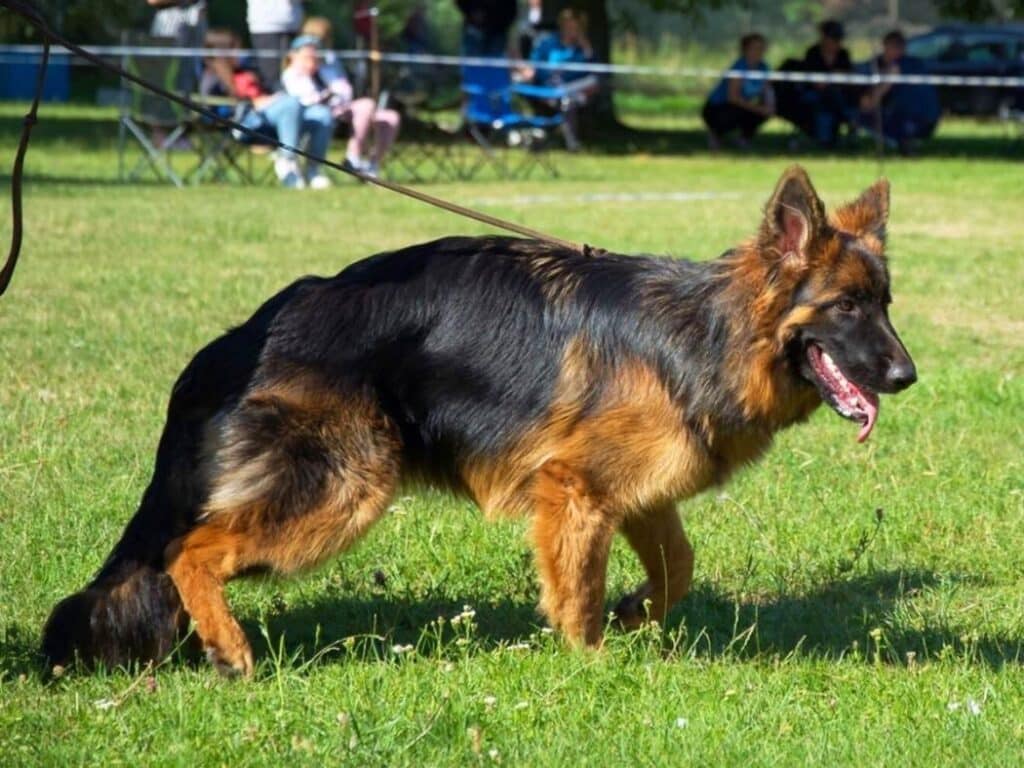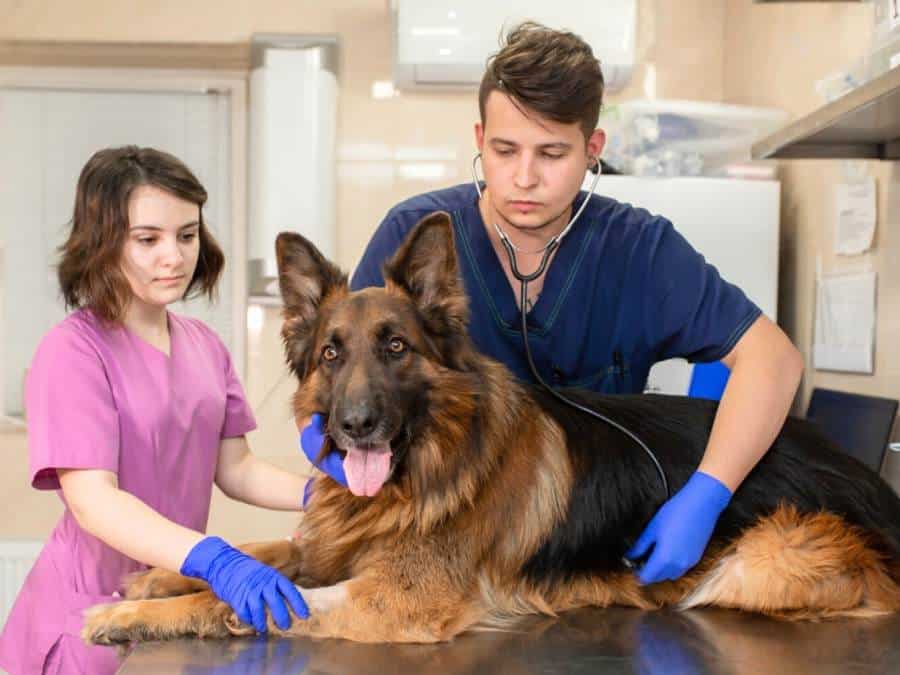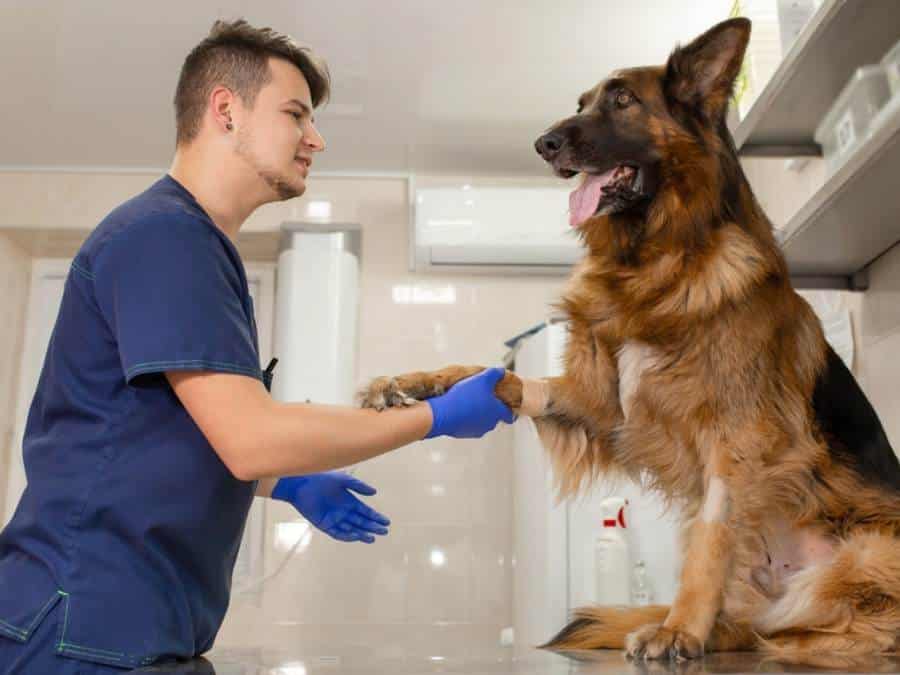Intact female German Shepherds (GSDs that have not been surgically spayed), and that are sexually mature go through a reproductive cycle called the heat cycle. This cycle consists of 4 stages, each with its own signs and behaviors.
Bleeding occurs in two of the four phases, so if you notice swelling of the vulva, bloody discharge, or other changes in behavior, don’t be alarmed. This just means, that your German Shepherd is experiencing her first heat cycle.
Here’s what to expect before, during, and after your German Shepherd’s heat cycle.
German Shepherd Heat Cycle: Overview
The following are certain facts about the German Shepherd heat cycle that will help you understand this process better.
- The first heat cycle will happen around the age of 6 to 12 months.
- GSDs typically have 2 heat cycles each year, that’s one heat cycle every 6 months.
- German Shepherd heat cycle can be divided into four main stages: proestrus, estrus, diestrus, and anestrus.
- The average female German Shepherd’s heat cycle lasts about 21 – 28 days.
- GSD is most fertile during the middle section (estrus phase) of her heat cycle, i.e. around 4 to 15 days after the heat cycle starts.
- The dog’s pregnancy lasts on average 63 days from ovulation.

German Shepherd Heat Cycle Chart
Below is a comprehensive German Shepherd Heat Cycle Chart that serves as a valuable visual aid to guide you through the different phases of your dog’s reproductive cycle.
This chart not only outlines the physiological changes your German Shepherd may undergo but also provides insights into behavioral patterns and potential signs of fertility.

4 Stages of the German Shepherd Heat Cycle
During the female’s heat cycle, you’ll notice four stages. The actual heat – or the season – includes the first two stages. After that, the fertile part of the cycle comes to an end, and the female will be no more receptive to mating.
1. Proestrus Stage – Preparing
The average length of the proestrus stage is 9 days but varies from 3 to 17 days.
Signs of the proestrus stage:
- Swelling of the vulva
- Bloody discharge
- Increased urination
- Mood swings (affectionate, agitated, quiet, anxious)
- Changes in appetite
- Male dogs will be attracted to her, but she’s not receptive to them.
- Tail tucking to cover her vulva, or sitting down if another dog approaches.
The main reason for these changes is the rising estrogen level in her body. In ovaries, the follicles – where the eggs are later released – are enlarging.
It’s crucial to keep a close eye on your dog during this stage as she may attract male dogs who are attracted to her scent but should not be allowed to mate at this point.
2. Estrus Stage – Breeding Time (Heat)
The estrus stage is when your German Shepherd is fertile and ready for breeding. This phase typically lasts around 9 days but can range from 4 to 18 days.
This is the time to ask yourself if you want a cute litter of puppies.
Signs of estrus phase (heat):
- The bloody vaginal discharge will gradually become lighter (pinkish) in color until it becomes clear or straw-colored. This indicates that ovulation has occurred and mating can take place.
- Your dog will become more receptive to male dogs. She may even pursue the mating partners
- The vulva is softening and swelling.
- Flagged tail: your dog might ‘flag’ her tail by moving it to the side, making herself available to males.
It’s important to closely supervise your German Shepherd during this stage if you do not intend to breed her, as male dogs can be persistent in their attempts to mate with her.
Keeping her indoors or away from other dogs can help prevent unwanted pregnancies.

3. Diestrus Stage – Gestation
The diestrus phase typically lasts around 60 – 90 days.
During diestrus, if mating has occurred and fertilization has taken place, your German Shepherd may experience pregnancy. If no mating has occurred, she will go through a false pregnancy where hormonal changes mimic pregnancy symptoms.
If there is a possibility of pregnancy, you might want to confirm it by taking her to the vet to get checked.
Signs of the diestrus phase:
- No discharge
- The vulva shrinks back to its normal size
- No interest in mating anymore
- Behavioral changes such as nesting behaviors or maternal instincts.
- Your dog may also experience physical changes such as weight gain and enlarged mammary glands.
Right after the estrus stage, the risk of pyometra, a uterus infection, is at its peak. If you notice a pus-like discharge coming from the dog’s vulva, you should immediately take her to the veterinarian.
4. Anestrus Stage – Recovery
The last phase of a German Shepherd’s heat cycle is the anestrus stage. This phase can last anywhere from 3 to 5 months.
During this time, your dog’s reproductive system takes a break and returns to its normal state, until the next proestrus stage begins.
If you’re planning to spay your German Shepherd, the anestrus period is considered the most effective time to do so.
It’s important to note that the duration and signs of each stage can vary among individual dogs and breeds. Monitoring these stages is crucial for responsible breeding practices or to prevent unwanted pregnancies.
RELATED:

When Do German Shepherds Go Into Heat?
The age at which a German Shepherd enters her first heat can vary, but it typically occurs between 6 and 12 months of age. Heat cycles will repeat around every six months throughout a GSD’s life as dogs do not go through menopause like humans.
German Shepherds can sometimes enter their heat cycle at a later age, around the age of 18 or 24 months. It all depends on the individual dog.
Every female German Shepherd will have her own cycle, and you will need to learn to anticipate it to help your dog through the process.
Moreover, just because your dog is in heat doesn’t mean they are ready for breeding.
German Shepherd breeders recommend waiting until the second or even third heat cycle. This allows the dog to fully mature and ensures a healthier pregnancy.
During the first heat, your dog’s eggs are not fully developed for reproduction. Waiting for subsequent cycles also allows your dog’s body to be fully prepared for gestation.
How Long Do German Shepherds Stay in Heat?
The duration of a German Shepherd’s heat cycle generally lasts for 21 – 28 days. However, the estrus phase, or the phase when she’s ready to mate and is fertile enough to get pregnant lasts 9 days but can range from 4 to 18 days.
It’s also important to keep in mind that if a female German Shepherd mates before her estrus period, she can become pregnant.
This study suggests that the sperm of male dogs can remain active inside the female’s reproductive system and survive for about 11 days.

Watch this video to learn more about the Female German Shepherd Heat Cycle…
Is My Female GSD in Heat? How Can I Tell?
If you own a female German Shepherd, it’s important to be able to recognize the signs that she is in heat.
Here are some signs that your female German Shepherd is in heat:
- Swollen Vulva: This swelling is caused by increased blood flow to the area and is often accompanied by a bloody discharge.
- Bloody Discharge: A bloody discharge is present during the proestrus stage, which transitions to a lighter color as the cycle progresses.
- Changes in Behavior: Your GSD may become more restless, anxious, or clingy. Additionally, she may show increased interest in male dogs and may attempt to attract their attention through vocalizations or posturing.
- Increased Urination: This is due to hormonal changes and the body’s natural response to attract potential mates.
- Changes in Appetite: Some female German Shepherds may experience changes in appetite during heat. They may either eat more or less than usual.
- Tail Position: When a female German Shepherd is in heat, she may hold her tail to the side or raise it slightly (flagging). This is a visual cue that she is ready for mating.
- Male Attention: Male dogs can sense when a female dog is in heat, even from a distance. If you notice an increase in male dogs approaching or showing interest in your female German Shepherd, it could be a sign that she is in heat.
- Licking and Cleaning: A female German Shepherd in heat may spend more time licking and cleaning her genital area. This is a natural instinct to keep the area clean and attract potential mates.
During this period, if you don’t want your female GSD to mate, then you must refrain from taking your dog to off-leash areas where she may come into contact with intact males. When a female German Shepherd is in heat, she emits pheromones that attract male dogs from miles away.
In the next section, let’s discuss more on the precautions to take when your female dog is in heat.

How to Care for a German Shepherd in Heat
When a female German Shepherd is in heat (estrus), it is important to provide extra care and attention to ensure her well-being and to prevent unwanted breeding. Here are some tips on how to care for a German Shepherd in heat:
- Isolate from Male Dogs: Keep your female German Shepherd away from intact male dogs to prevent unwanted mating. This may involve keeping her indoors or closely supervised on a leash during walks.
- Secure Your Yard: If your German Shepherd spends time in a yard, make sure it is securely fenced to prevent male dogs from entering. During heat, female dogs can be particularly determined to find a mate, so extra precautions are necessary.
- Use Doggie Diapers or Pants: To help control any discharge and prevent messes in your home, consider using these disposable doggie diapers designed for female dogs in heat.
- Regular Walks and Exercise: Continue to provide regular exercise, but be mindful of potential encounters with other dogs. On-leash walks can be a safer option during this time.
- Maintain a Regular Feeding Schedule: Stick to your dog’s regular feeding schedule to maintain her overall health. Ensure she has access to fresh water at all times.
- Comfort and Support: Some dogs may experience mood changes or discomfort during their heat cycle. Provide extra comfort, attention, and support to help alleviate any stress or anxiety.
If you have any concerns or questions about caring for your German Shepherd during her heat cycle, it is always best to consult with a veterinarian. They can provide guidance specific to your dog’s needs and offer advice on managing any potential health issues that may arise during this time.

How Often Does a German Shepherd Go Into Heat?
The heat cycle, or estrous cycle, of a female German Shepherd typically occurs approximately every six months, but there can be variation among individual dogs. The timing and frequency of heat cycles can be influenced by factors such as age, health, seasons, and environmental conditions.
Age
Female GSDs typically experience their first heat cycle between 6 and 12 months of age. However, as dogs age, the frequency of heat cycles can vary.
As German Shepherds get older, their heat cycles become less frequent. However, it’s important to note that your dog will still go through estrus throughout her life and can still become pregnant, even though the number of estrus seasons may decrease.
Health
The general health of the dog can influence the regularity of heat cycles. Illness or underlying health issues may disrupt the normal hormonal balance and affect the timing and regularity of estrous cycles.
Seasonal Influences
Some female German Shepherds, may have heat cycles influenced by seasonal changes. In certain climates, dogs might experience more regular cycles or show preferences for specific times of the year.
Breeding History
- Previous Pregnancies: If a female has been pregnant or has undergone a false pregnancy (pseudopregnancy), it can influence the timing of subsequent heat cycles.
- Breeding Practices: Dogs that are bred regularly may have different reproductive patterns compared to those that are not bred.
It’s important to note that individual dogs can vary, and not every German Shepherd will follow the same pattern. If you have concerns about your dog’s reproductive health or if you’re considering spaying, it’s recommended to consult with a veterinarian.
Breeding Vs. Spaying Your GSD
Spaying, or ovariohysterectomy, is the surgical removal of a female dog’s reproductive organs. It is a common procedure recommended by veterinarians for several reasons.
Many people believe that a female GSD MUST have a litter before getting spayed, but that’s actually a myth.
The decision of whether or not to spay your pet is not straightforward and has both advantages and disadvantages that can impact your dog’s health in unexpected ways.
Research has shown that there are pros and cons to consider when making this decision.
Pros:
- Prevents unwanted pregnancies: By removing the ovaries and uterus, spaying prevents your dog from going into heat and reduces the chances of her getting pregnant.
- Reduces the risk of certain health issues: Spaying your dog at an early age can help prevent various reproductive health problems such as uterine infections (pyometra) and mammary tumors.
- Eliminates heat-related behaviors: Female dogs in heat can display undesirable behaviors such as excessive vocalization, restlessness, and attracting male dogs. Spaying eliminates these behaviors, making your dog calmer and easier to manage.
- No more messy heat cycles: Female dogs in heat experience bloody discharge, which can be messy and inconvenient for pet owners. Spaying eliminates the heat cycle altogether, saving you from dealing with this hassle.
Cons:
- Surgical risks: While it is a routine procedure, complications such as infection, reaction to anesthesia, or excessive bleeding can occur. However, these risks are relatively low when performed by a qualified veterinarian.
- Potential weight gain: This is because the removal of reproductive organs can alter their metabolism and hormonal balance.
- Possible changes in behavior: Some dog owners report changes in behavior after spaying their pets. While not always the case, some dogs may become more sedentary or exhibit a
Genetic factors play a significant role in determining whether or not spaying is the best choice for your German Shepherd. This is why it is extremely important to get your GSD from trustworthy sellers who will carry out the necessary health screening before breeding to minimize the risk of certain conditions that can be affected by spaying.
Conclusion
Congratulations! You now have a better understanding of the German Shepherd heat cycle. By recognizing the signs and stages of your dog’s heat cycle, you can provide the care and attention she needs during this time. Remember to be vigilant in monitoring her behavior and take necessary precautions to prevent unwanted pregnancies. Whether you choose to spay your German Shepherd or not, it is essential to prioritize her reproductive health.
Frequently Asked Questions
How often do German Shepherds go into heat?
German Shepherds typically go into heat twice a year, although this can vary. The average interval between heat cycles is about six to eight months.
1. How long does a German Shepherd bleed when in heat?
A female German Shepherd typically experiences heat, or estrus, for about 2 to 4 weeks, with bleeding occurring during the first half of this period.
2. What to do when your GSD is in heat?
When your German Shepherd is in heat, it’s essential to keep her indoors and away from male dogs to prevent mating. Consider using doggy diapers and providing extra attention and care during this time.
3. When should a female German Shepherd be spayed?
The ideal time to spay a female German Shepherd is before her first heat cycle, usually between 6 and 9 months of age. However, consulting with a veterinarian is crucial to determine the best timing based on individual health and circumstances.
4. How do female German Shepherds behave during the first heat?
During the first heat, female German Shepherds may display changes in behavior, including increased affection, restlessness, and attraction to male dogs. They may also exhibit signs like a swollen vulva and a bloody discharge.
Also read:




